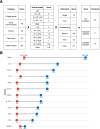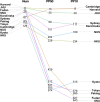Faculty appointment and promotion in Taiwan's medical schools, a systematic analysis
- PMID: 35538519
- PMCID: PMC9088140
- DOI: 10.1186/s12909-022-03435-2
Faculty appointment and promotion in Taiwan's medical schools, a systematic analysis
Abstract
Background: A rigorous faculty appointment and promotion (FAP) system is vital for the success of any academic institution. However, studies examining the FAP system in Asian universities are lacking. We surveyed the FAP policies of Taiwan's medical schools and identified an overreliance on the CJA score (manuscript Category, Journal quality, and Author order). The potential shortcomings of this metric and recommendations for refinement were discussed.
Methods: We obtained the FAP documents from all 12 medical schools in Taiwan, and analyzed their use of traditional versus non-traditional criteria for FAP according to a published methodology. The influence of the journal impact factor (JIF) on the FAP process was quantified by comparing its relative weight between papers with two extreme JIFs. To better understand the research impact and international standing of each school, we utilized the public bibliographic database to rank universities by the number of papers, and the proportions of papers within the top 10% or 50% citation.
Results: Compared with other countries, Taiwan's medical schools focus more on the quantifiable quality of the research, mostly using a "CJA" score that integrates the category, JIF or ranking, and authorship of a paper, with the JIF being the most influential factor. The CJA score for an article with a JIF of 20 can be up to three times the threshold for promotion to Assistant Professor. The emphasis on JIF is based on a presumed correlation between JIF and citation counts. However, our analysis shows that Taiwan's medical schools have lower-than-average citation counts despite a competitive rank in the number of publications.
Conclusions: The JIF plays an unrivaled role in determining the outcome of FAP in Taiwan's medical schools, mostly via the CJA system. The questionable effectiveness of the current system in elevating the international standing of Taiwan's higher-education institutions calls for a re-examination of the FAP system. We recommend a reduction in the relative importance of CJA score in the FAP system, adopting more rigorous metrics such as the h-index for evaluating research quality, and supporting more research aimed at improving the FAP system.
Keywords: Faculty; Journal impact factor; Medical education; Research.
© 2022. The Author(s).
Conflict of interest statement
None.
Figures



Similar articles
-
Integrity of the editing and publishing process is the basis for improving an academic journal's Impact Factor.World J Gastroenterol. 2022 Nov 21;28(43):6168-6202. doi: 10.3748/wjg.v28.i43.6168. World J Gastroenterol. 2022. PMID: 36483155 Free PMC article.
-
Journal- or article-based citation measure? A study of academic promotion at a Swiss university.F1000Res. 2020 Oct 1;9:1188. doi: 10.12688/f1000research.26579.1. eCollection 2020. F1000Res. 2020. PMID: 33149900 Free PMC article.
-
The ups and downs of journal impact factors.Ann Occup Hyg. 2008 Mar;52(2):73-82. doi: 10.1093/annhyg/men002. Ann Occup Hyg. 2008. PMID: 18316351 Review.
-
Journal publications from Zagreb University Medical School in 1995-1999.Croat Med J. 2003 Dec;44(6):681-9. Croat Med J. 2003. PMID: 14652879
-
Questioning the Impact of the Impact Factor. A Brief Review and Future Directions.Semin Ophthalmol. 2022 Jan 2;37(1):91-96. doi: 10.1080/08820538.2021.1922713. Epub 2021 May 9. Semin Ophthalmol. 2022. PMID: 33969807 Review.
Cited by
-
Trends and hotspots related to traditional and modern approaches on acupuncture for stroke: A bibliometric and visualization analysis.Medicine (Baltimore). 2023 Dec 1;102(48):e35332. doi: 10.1097/MD.0000000000035332. Medicine (Baltimore). 2023. PMID: 38050290 Free PMC article.
-
Exploring the top-cited literature in telerehabilitation for joint replacement using the descriptive, diagnostic, predictive, and prescriptive analytics model: A thematic and bibliometric analysis.Medicine (Baltimore). 2023 Dec 1;102(48):e36475. doi: 10.1097/MD.0000000000036475. Medicine (Baltimore). 2023. PMID: 38050200 Free PMC article.
-
Analyzing shifts in age-related macular degeneration research trends since 2014: A bibliometric study with triple-map Sankey diagrams (TMSD).Medicine (Baltimore). 2024 Jan 19;103(3):e36547. doi: 10.1097/MD.0000000000036547. Medicine (Baltimore). 2024. PMID: 38241545 Free PMC article.
-
A leading bibliometric author does not have a dominant contribution to research based on the CJAL score: Bibliometric analysis.Medicine (Baltimore). 2023 Jan 13;102(2):e32609. doi: 10.1097/MD.0000000000032609. Medicine (Baltimore). 2023. PMID: 36637941 Free PMC article.
-
Analysis of citation trends to identify articles on delirium worth reading using DDPP model with temporal heatmaps (THM): A bibliometric analysis.Medicine (Baltimore). 2023 Feb 22;102(8):e32955. doi: 10.1097/MD.0000000000032955. Medicine (Baltimore). 2023. PMID: 36827058 Free PMC article.
References
MeSH terms
Grants and funding
LinkOut - more resources
Full Text Sources
Miscellaneous

